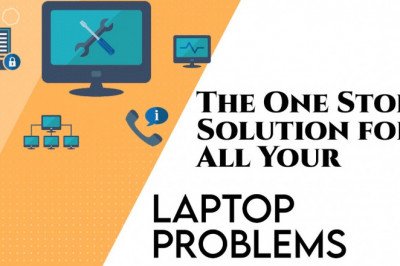views
Robotic Process Automation (RPA) technology allows businesses to automate repetitive tasks currently performed by humans. RPA systems can automate tasks, including data entry, customer service, and order processing.
As RPA systems become more widespread, there is an increasing focus on security. RPA systems can be vulnerable to various security risks, including data breaches, unauthorized access, and cyber attacks.
There are some steps that businesses can take to mitigate the security risks associated with RPA systems. These include:
Data encryption
Data encryption converts data into a scrambled format that authorized individuals can only decrypt. This is an important security measure for RPA development company services systems because it helps to protect sensitive data from unauthorized access.
There are different ways to encrypt data; the best approach will depend on the business's specific needs. Some common encryption methods include:
- Symmetric encryption: This is the most common type of encryption, and it uses a single key to encrypt and decrypt data.
- Asymmetric encryption: This type of encryption uses a public and private key to encrypt and decrypt data. The public key is shared with anyone who wants to send encrypted messages, while the recipient keeps the private key secret.
- Hashing: This is a process of transforming data into a unique value that can be used to verify the integrity of the data.
Access controls
Access controls determine who has access to what data and systems. This is an important security measure for RPA systems because it helps to prevent unauthorized access to sensitive data and systems.
There are different ways to implement access controls, and the best approach will depend on the business's specific needs. Some common access control methods include:
- Role-based access control (RBAC): This type of access control assigns permissions based on the user's role in the organization.
- Discretionary access control (DAC): This type of access control allows users to grant access to their files and folders to other users.
- Mandatory access control (MAC): This type of access control requires users to have specific permission to access a file or folder.
Intrusion detection systems
Intrusion detection systems (IDS) monitor networks for suspicious activity. This is an important security measure for RPA systems because it helps to detect and prevent unauthorized access to sensitive data and systems.
There are different types of IDS, and the best approach will depend on the business's specific needs. Some common IDS methods include:
- Snort: This is a popular open-source IDS that can monitor networks for various threats.
- Suricata: This is another popular open-source IDS that can monitor networks for multiple threats.
- Network IPS: This type of IDS is deployed on the network itself and can be used to monitor various threats.
- Host-based IDS: This type of IDS is deployed on individual computers and can be used to monitor multiple threats.
Educating employees
Employee education is an important part of any security program. Employees should be educated about the security risks associated with RPA systems and how to protect themselves. This includes:
- Training employees about the importance of data encryption
- Training employees about the importance of access controls
- Training employees about the importance of intrusion detection systems
- Training employees about the importance of phishing scams
- Training employees about the importance of social engineering attacks
Monitoring systems
Monitoring systems are important for detecting and preventing security breaches. Businesses should monitor their RPA systems for suspicious activity, such as:
- Unusual login activity
- Unusual file access activity
- Unusual network traffic activity
By monitoring their RPA systems, businesses can help to identify and prevent security breaches.
One real-life example of an RPA security risk is the case of a company that used RPA tools to automate the process of processing customer orders. The company's RPA lifecycle system was connected to the company's customer database, which contained sensitive personal information such as credit card numbers and addresses.
One day, the company's RPA system was compromised by a cyber attacker. The attacker could take over access to the customer database and steal the sensitive personal information of thousands of customers. The government fined the company for failing to protect the personal information of its customers.
This real-life example illustrates the importance of mitigating the security risks associated with RPA systems. By implementing security measures, educating employees, monitoring systems, and testing systems, businesses can help to protect their RPA systems from cyber attacks and other security risks.
Here are some additional tips for keeping your RPA systems safe:
- Strong Passwords: Strong passwords are essential for protecting any system, not just RPA systems. Passwords should be at least 12 characters long and include a mix of upper and lowercase letters, numbers, and symbols. It is important to avoid using the same password for multiple accounts, as this makes it easier for hackers to access your funds if they can crack one of your passwords.
- Keeping software up to date: Software updates often include security patches that can help to protect your systems from vulnerabilities. Be sure to install all software updates as soon as they become available, as these updates can often help to prevent your system from being compromised.
- Be careful what you click on: Malicious links can install malware on your system or steal your personal information. Be cautious about what you click on in emails and websites, and only click on links from trustworthy senders. If you are unsure whether a link is safe, it is always best to err on caution and not click on it.
- Using a firewall: A firewall can help to protect your systems from unauthorized access. Configure your firewall to allow only authorized traffic and block any unauthorized traffic. A firewall can also help to protect your system from malware, as it can block malicious websites and files from being accessed.
- Backing up your data: It is important to back up your data regularly in case your system is compromised. Backed-up data can be restored if your system is infected with malware or if your data is accidentally deleted. Different ways to back up your data include using cloud storage, an external hard drive, or a USB drive.
By following these tips, you can help to keep your RPA evolution systems safe and protect your data from unauthorized access, cyber-attacks, and other security risks.
In addition to the above, here are some other tips for keeping your RPA systems safe:
Using a secure RPA platform:
Some different RPA platforms are available, and not all are created equal. When choosing an RPA platform, select one with a strong security focus. Some of the factors to consider when selecting a secure RPA platform include the following:
- The platform's security features
- The platform's compliance with RPA industry standards
- The platform's reputation for security
Using secure coding practices:
When developing RPA bots, use certain coding practices. This includes using strong passwords, encrypting sensitive data, and avoiding open-source code that may be vulnerable to security risks. Some of the safe coding practices that should be used when developing RPA bots include:
- Using strong passwords for all accounts
- Encrypting sensitive data
- Using secure libraries and frameworks
- Testing code for security vulnerabilities
Testing RPA bots:
Before deploying any RPA bots, test them thoroughly to identify potential security risks. Testing RPA bots should include both manual and automated tests. Human testers should conduct manual tests, while the software should complete computerized tests. Automated tests can be used to test many bots quickly and easily.
Monitoring RPA systems:
Once your RPA bots are deployed, monitor them regularly for suspicious activity. Monitoring RPA systems can help to identify security threats early on before they can cause significant damage. Some of the ways to monitor RPA systems include:
- Using a SIEM (Security Information and Event Management) system
- Using an RPA monitoring tool
- Manually reviewing logs
- Monitoring for unauthorized access
Updating RPA systems:
Like any other software, RPA systems must be updated regularly to include security patches and bug fixes. Be sure to update your RPA systems as soon as updates are available. Updating RPA systems can help to protect your systems from known vulnerabilities.
Be prepared for a breach:
Even if you take all the necessary steps to keep your RPA development systems safe, there is always the possibility of a violation. If a breach occurs, be prepared to mitigate the damage and protect your data. Some of the steps that will be taken in the event of a breach include the following:
- Contain the breach
- Investigate the breach
- Notify affected parties
- Remediate the breach
- Monitor the breach
By following these tips, you can help to keep your RPA systems safe and secure.
Conclusion
In conclusion, there are several things that businesses can do to keep their RPA systems safe. By following the tips in this article, companies can help to protect their systems from unauthorized access, data breaches, and other security threats. By taking these steps, businesses can help to ensure that their RPA systems are used safely and securely.











